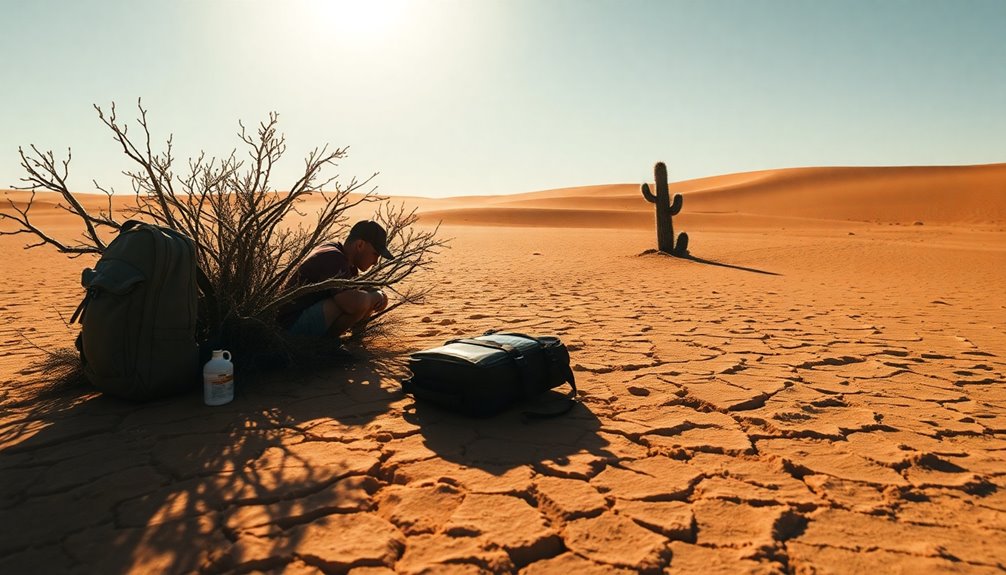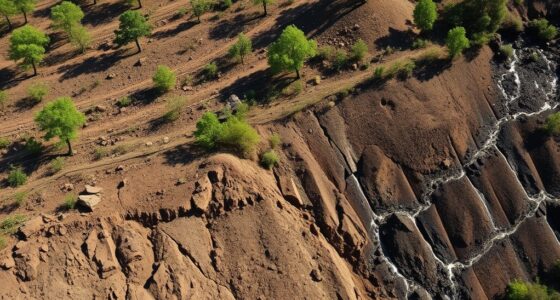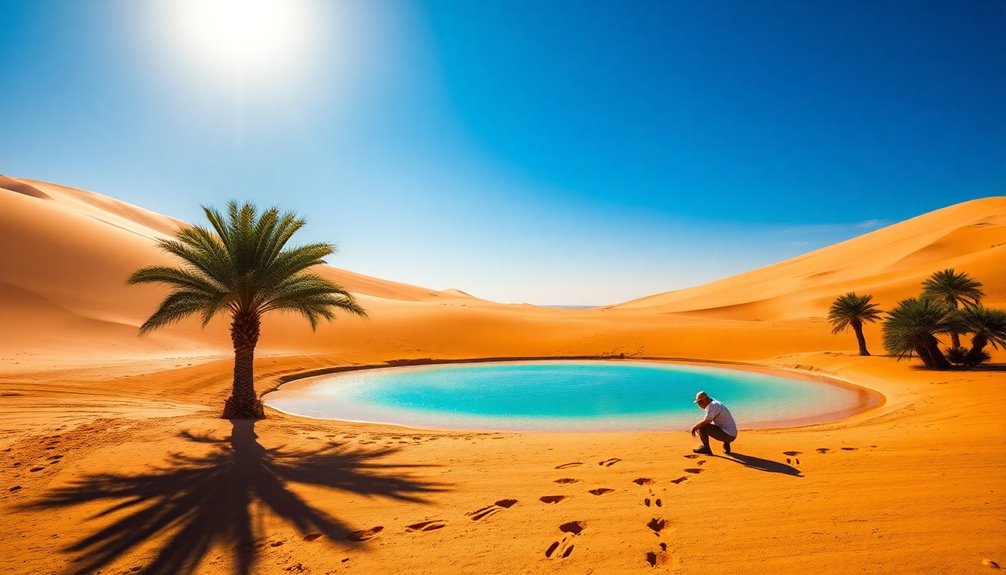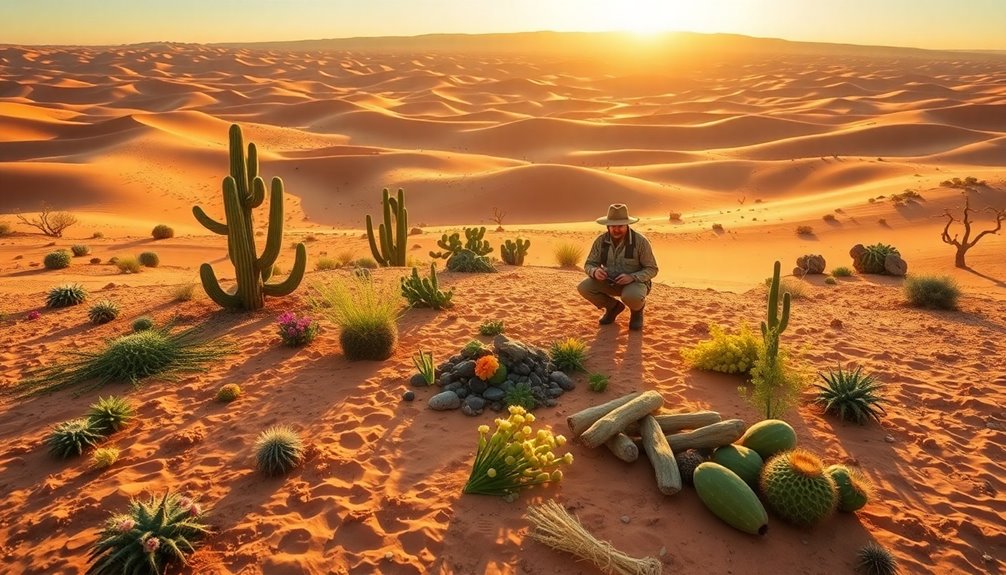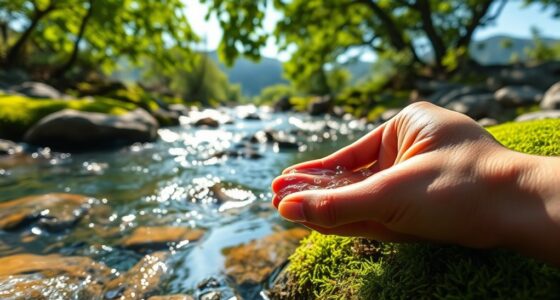Surviving in the desert requires smart strategies to handle extreme heat and limited resources. First, stay hydrated by drinking 1-2 quarts of water per hour, especially in intense heat. Monitor your urine color to gauge hydration. Build a shelter to protect against temperature extremes and use sunscreen for skin protection. Develop navigation skills to avoid getting lost, and familiarize yourself with local plants for food. Lastly, maintain a positive mindset to enhance adaptability. There's plenty more to explore that can help you navigate challenges and ensure your survival in harsh environments.
Key Takeaways
- Carry at least 4 to 6 quarts of water daily and monitor urine color to ensure proper hydration in extreme heat.
- Construct shelters using available materials for protection against harsh weather and temperature extremes.
- Wear light, loose clothing and apply sunscreen to minimize sun exposure and reduce the risk of heat-related illnesses.
- Familiarize yourself with local flora and fauna to identify edible plants and avoid dangerous wildlife.
- Maintain a positive survival mindset by setting achievable goals and practicing stress management techniques.
Introduction
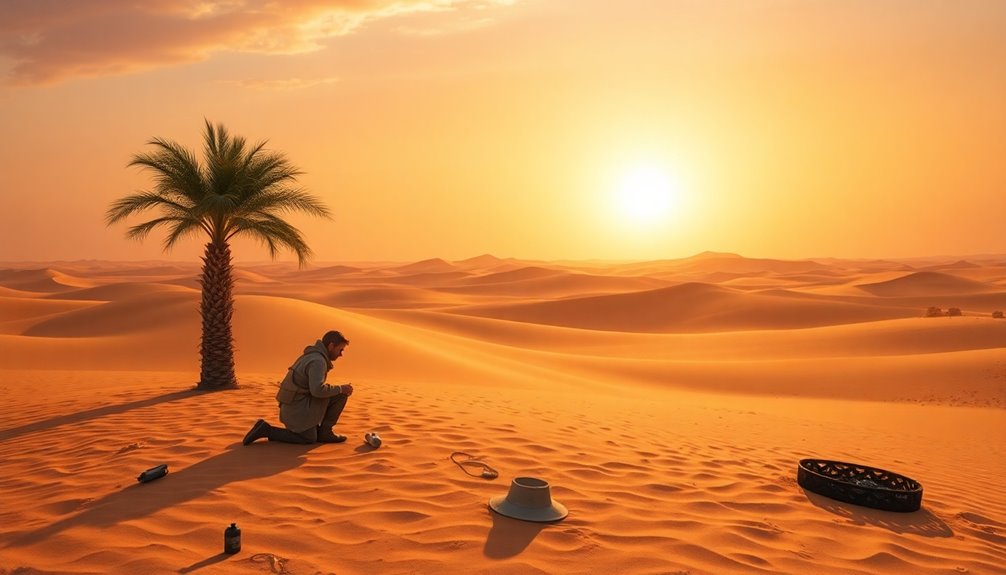
When you find yourself in a desert, survival essentials become your lifeline.
It's not just about having the right gear; your mindset plays a crucial role in navigating extreme conditions.
Being prepared and staying calm can make all the difference between life and death.
Survival Essentials in Extreme Conditions
Surviving in extreme desert conditions demands careful planning and knowledge of essential strategies.
First, understand how much water you'll need; aim for 4 to 6 quarts per person per day to stay hydrated and ward off heat-related illnesses.
Wear light-colored, loose-fitting clothing to reflect sunlight and minimize heat absorption, and find shade whenever possible during the hottest parts of the day.
Equip yourself with essential supplies, including shelter materials, sunscreen, and a first aid kit.
If you find yourself stranded, stay with your vehicle, as it can offer crucial shelter and is easier for searchers to locate.
Lastly, familiarize yourself with local flora and fauna to identify edible plants and avoid wildlife hazards.
Survival Mindset Importance
Harnessing a positive survival mindset can be your greatest asset in the unforgiving desert environment. This mindset significantly boosts your ability to adapt and respond to challenging situations.
Studies show that maintaining hope improves decision-making, increasing your chances to stay alive when facing life-threatening circumstances. By focusing on achievable goals, like finding water or building shelter, you'll reduce feelings of helplessness and encourage proactive behaviors.
Developing mental resilience through training and experience equips you with vital coping strategies for managing stress and fear. The U.S. Army emphasizes that mental fortitude, alongside practical survival skills, is essential for overcoming the psychological challenges posed by harsh environments like deserts.
Cultivating this survival mindset could make all the difference in your journey.
Survival Skills Overview
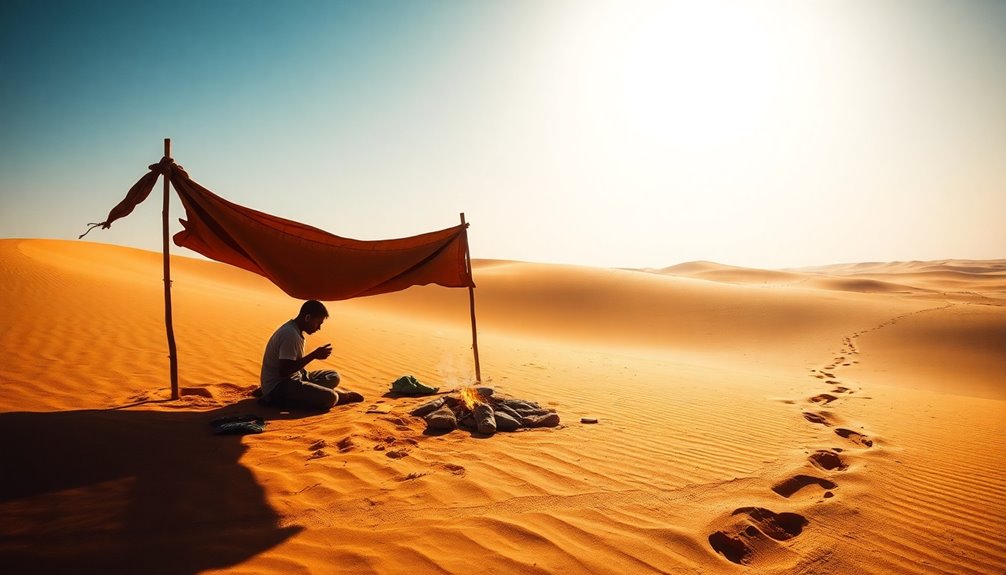
In the desert, mastering survival skills is crucial for your safety and well-being.
First, ensure you carry a minimum of 4 to 6 quarts of water per person per day to stay hydrated in extreme heat. You'll also need effective heat exposure management techniques; rest in the shade during peak sun hours and watch for signs of heat exhaustion or heat stroke.
Constructing shelters, like simple shade structures, can help protect you from harsh temperatures.
Navigation skills are vital too—learning to use maps or identifying natural landmarks can prevent you from getting lost in featureless terrain.
Lastly, acquire basic first aid knowledge for managing potential wildlife encounters, like snakebites and scorpion stings, ensuring your safety in the desert environment.
Essential for Long-Term Survival
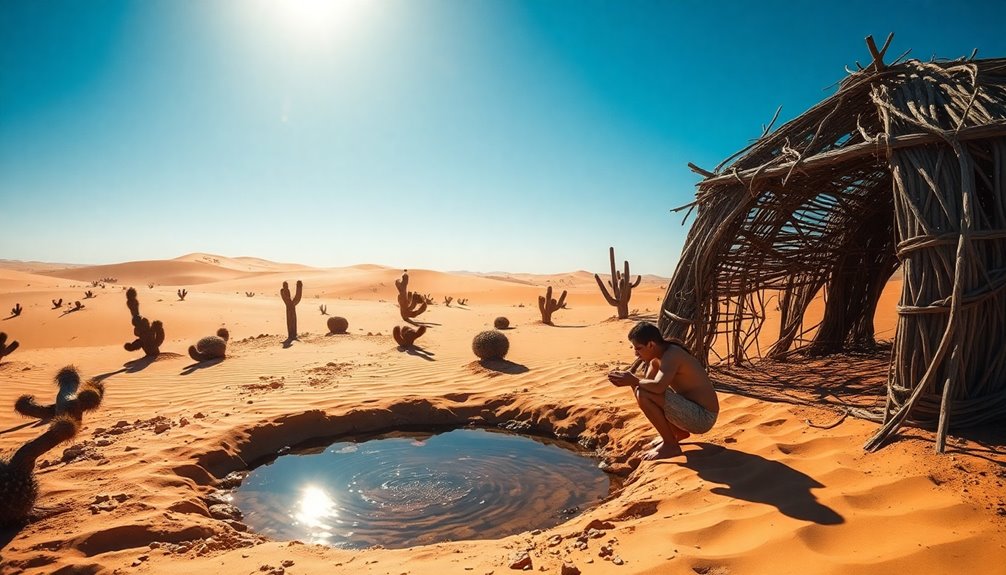
In the desert, every decision can be a matter of life or death, so honing your decision-making skills is vital.
You need to stay aware of your surroundings, as understanding the environment will help you make informed choices about shelter, food, and water.
Life-Or-Death Decision-Making Skills
Facing the harsh realities of desert survival, assessing your physical and mental condition becomes paramount. A calm, focused mindset enhances your decision-making and boosts your chances of survival.
Early in the morning or late in the evening, prioritize your needs using the survival triage approach: shelter first, then water, and lastly food.
When deciding whether to stay with your vehicle or hike out, evaluate your water supply and physical state. Staying put often offers shelter and increases visibility for rescue.
Always have an emergency plan that includes when to ration supplies, as limiting activity and conserving energy are crucial for prolonged survival. Practicing situational awareness will guide you in making life-or-death decisions effectively.
Environmental Awareness
Understanding the desert environment is key to ensuring your long-term survival. You need to make sure to adapt to temperature fluctuations, as daytime highs can exceed 100°F while nighttime lows may drop below freezing.
Design shelters that provide shade during the scorching hours, and ensure they're windproof to protect against strong gusts. Morning or late afternoon is the best time to collect water; being close to sources will save energy.
Also, be mindful of local wildlife; your shelter should deter encounters with snakes and scorpions. Finally, consider the space requirements—plan for at least 50 square feet per person to ensure comfort and safety.
Environmental awareness will significantly enhance your chances of survival in the desert.
Desert Hydration Methods
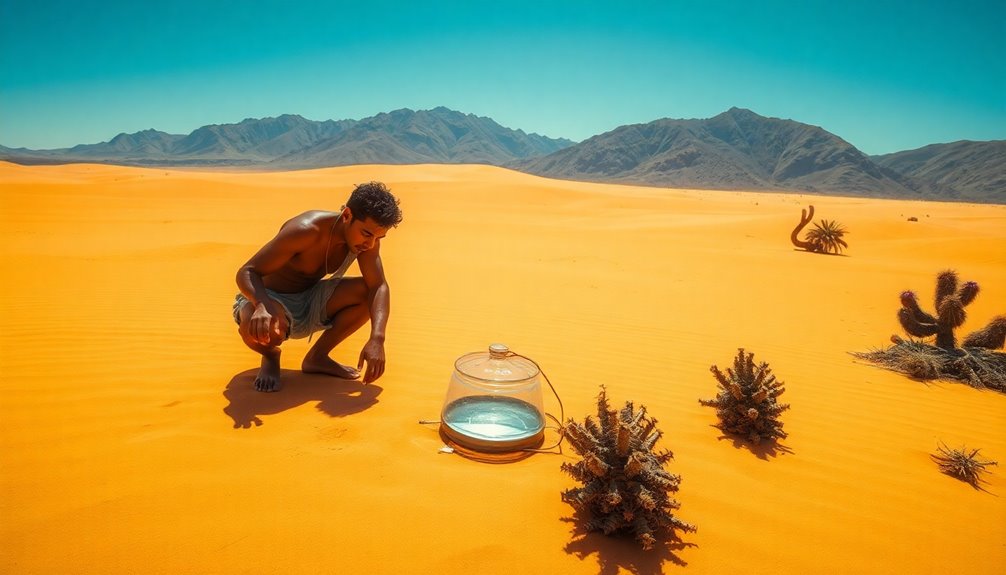
Staying hydrated in the desert is crucial for survival, especially when temperatures soar above 90°F. You should aim to drink at least 4 to 6 quarts of water daily.
Monitor your urine color and volume; dark urine means dehydration, while light-colored urine indicates you're adequately hydrated. To avoid hyponatremia, add salt or sports drink mix to your water, particularly during intense activities.
When stranded, drink small amounts of water frequently instead of rationing it, as this helps maintain your energy and cognitive function. In extreme heat, the U.S. Army advises consuming 1-2 quarts of water per hour to prevent heat-related illnesses.
Stay vigilant about your hydration to increase your chances of survival in the desert.
Survival Gear Recommendations
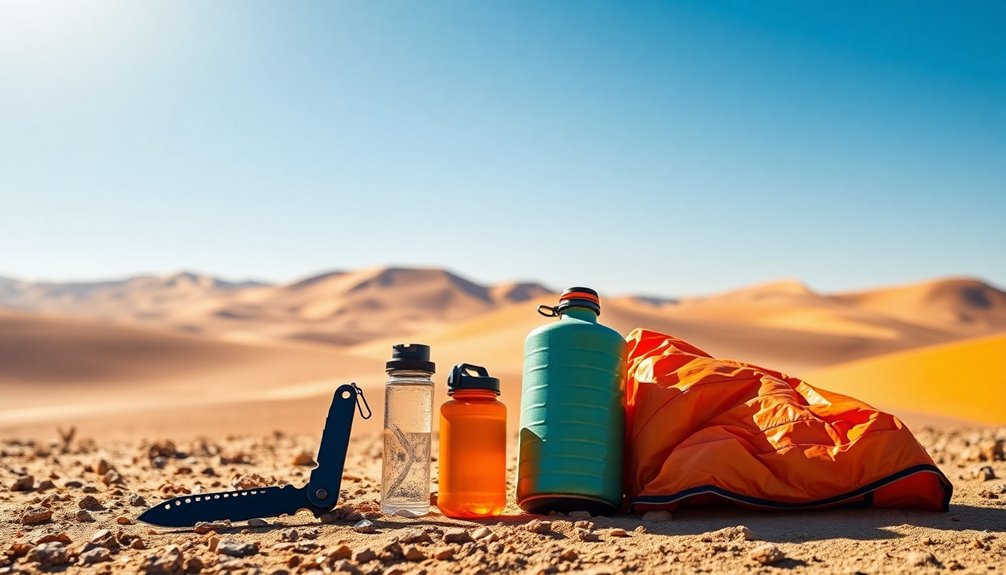
In the desert, having the right gear can make all the difference in your survival. Start with a well-stocked survival kit containing at least 4 to 6 quarts of water per person per day to combat dehydration.
Essential tools for building shelter include a utility knife, multi-tool, quality tarp, and cordage, allowing you to create effective protection from the elements. A personal locator beacon is crucial; it significantly boosts your chances of being rescued if stranded.
Additionally, pack water purification tablets, a GPS device, and a satellite phone to enhance safety and communication while navigating remote areas.
Finally, don't forget lightweight, UPF-rated clothing to shield yourself from the sun and minimize heat exposure. Stay prepared, and you'll increase your odds of survival.
Water Conservation Techniques
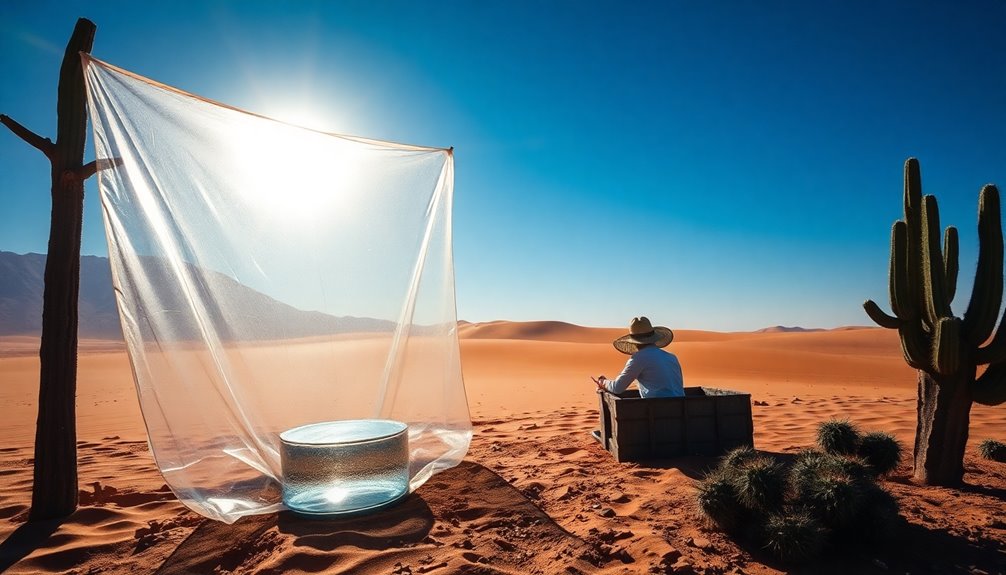
Water is your most precious resource in the desert, and knowing how to conserve it can mean the difference between life and death.
To survive, try to drink at least 1-2 quarts of water per hour, especially when temperatures soar above 100°F. Avoid eating foods that require a lot of hydration for digestion, as prioritizing water is key.
Use shade and shelter to minimize sweat loss, and rest during peak sun hours (11 am – 2 pm) to reduce your water needs. Wear light-colored, loose-fitting clothing to help regulate your body temperature and minimize sweat.
Lastly, keep an eye on your urine's color and volume; dark urine signals dehydration, while clear urine indicates proper hydration. Stay vigilant!
Heat-Related Health Issues
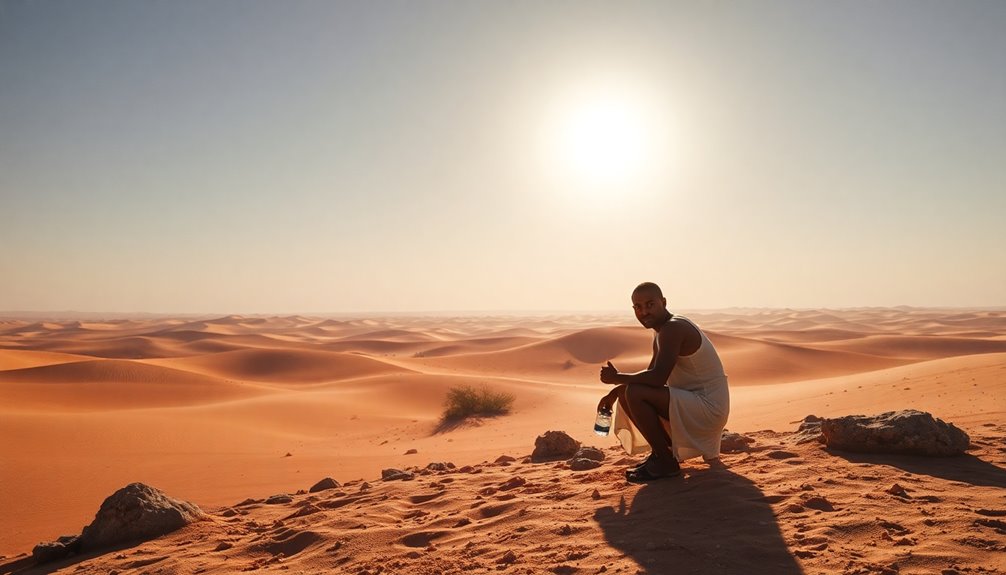
When you're out in the desert, staying aware of heat-related health issues is crucial for your survival.
Make sure you stay hydrated at all times, as dehydration can sneak up on you quickly.
Also, be mindful of the wildlife around you, as their behavior can signal changes in the environment that may impact your safety.
Desert Wildlife Awareness Tips
Recognizing heat-related health issues is crucial for anyone venturing into the desert, where extreme temperatures can quickly become dangerous. Each year, around 650 heat-related deaths occur in the U.S., emphasizing the need to stay alert.
Watch for symptoms of heat exhaustion, like nausea, dizziness, and irritability; if these escalate, you risk heat stroke, which requires immediate cooling and medical attention. Remember, heat stroke happens when your body's temperature hits 105°F.
The risk of dehydration rises in high heat, so aim to drink 1-2 quarts of water per hour. Protect yourself by wearing long, loose clothing, using UPF-rated fabrics, and applying sunscreen to reduce the risk of heat-related illnesses while navigating the harsh desert landscape.
Stay Hydrated at All Times
Staying hydrated is essential for your safety in the unforgiving desert heat. In extreme temperatures, you may need up to 2.5 gallons of water daily, especially when it exceeds 90°F.
It's vital to pack 4 to 6 quarts of water per person each day to combat dehydration risks. Keep an eye on your urine color; clear or light-colored urine means you're hydrated, while dark urine signals dehydration.
Remember, you can lose 1-2 quarts of water every hour in these harsh conditions, so drink constantly. To prevent hyponatremia, consider adding salt or a sports drink mix to your water, ensuring your electrolytes stay balanced.
Prioritize hydration, and you'll significantly increase your chances of survival.
Survivor Stories From Desert Expeditions

Surviving in the harsh conditions of the desert often hinges on quick thinking and resourcefulness, as demonstrated by various adventurers who faced dire circumstances.
In 2006, hikers in Death Valley managed to survive for days without water by rationing supplies and staying near their vehicle, which helped search teams find them.
A solo adventurer lost in the Mojave Desert in 2015 navigated back to safety using natural landmarks and the sun's position.
In 2018, a family camping in Arizona protected themselves from a sudden storm by crafting a makeshift shelter.
A man stranded in the Great Sandy Desert survived over a week by foraging for edible plants, while off-roaders in the Sonoran utilized emergency supplies for a successful rescue in 2020.
Conclusion
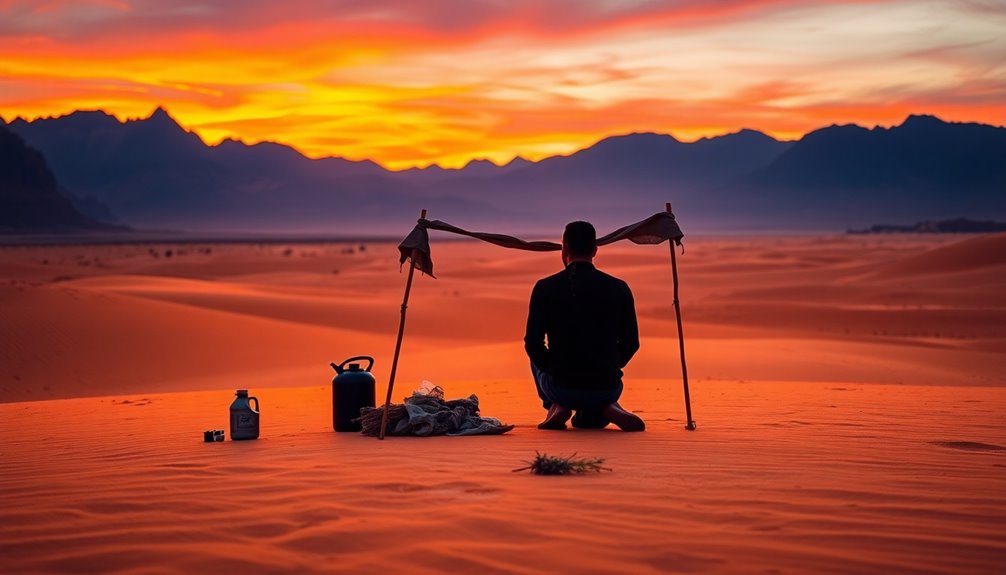
Successfully navigating the challenges of desert survival requires a blend of preparation and adaptability.
You need effective shelter construction techniques to shield yourself from extreme temperatures and relentless sunlight. Carry at least one gallon of water daily and monitor your hydration to combat severe dehydration.
Be aware of local wildlife and potential hazards, and have first aid knowledge ready for any bites or stings. Developing navigation skills, such as using compasses and celestial bodies, is essential for traversing featureless landscapes.
Lastly, maintaining a positive mental attitude and adapting to changing conditions can significantly enhance your chances of survival.
Additional Resources
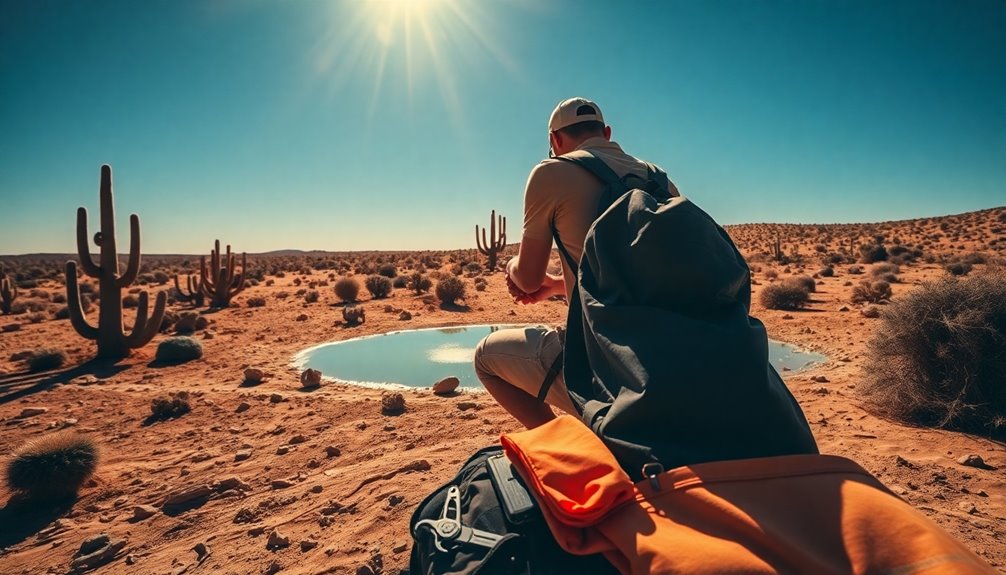
To bolster your desert survival skills, tapping into a variety of resources can make a significant difference.
Start with survival guides and instructional videos that teach you about shelter construction, hydration strategies, and navigation techniques tailored for harsh climates.
Online forums and wilderness survival communities also offer valuable tips and shared experiences from seasoned survivalists.
Consider reading books focused on desert survival for deeper insights into local flora, water sourcing, and emergency preparedness.
Mobile apps designed for outdoor survival can help with navigation, weather updates, and emergency communication.
Lastly, attending workshops or courses provides practical experience in shelter building, food procurement, and first aid, equipping you with essential skills for thriving in the desert.
Frequently Asked Questions
How Did People Survive the Difficult Desert Environment?
People survived the difficult desert environment by mastering local resources and techniques.
You'd learn to identify edible plants and find water through methods like dew harvesting.
Building temporary shelters from available materials provides shade and protection.
You might follow seasonal migration patterns to stay near water and food.
Additionally, you'd rely on celestial navigation to traverse vast landscapes, using stars and landmarks to guide your way through the featureless terrain.
What Are the 5 Ways to Survive in the Desert?
To survive in the desert, drink at least a gallon of water daily to stay hydrated.
If you get stranded, stay with your vehicle; it offers shelter and visibility.
Construct effective shade using tarps or natural features to protect against extreme heat.
Limit your activity during peak sunlight hours, focusing on conserving energy.
Lastly, familiarize yourself with local plants and animals to identify potential food and water sources while avoiding dangers.
How Do People Survive in the Desert Climate?
To survive in the desert climate, you need to focus on hydration first. Carry plenty of water—about 4 to 6 quarts daily.
Wear light, loose clothing to keep cool and protect your skin. You'll want to find or create shade to escape the extreme heat.
Limit your activity when the sun's at its peak, and stay aware of potential dangers, including wildlife.
It's all about managing your resources and staying calm.
How Can We Stay Safe in a Desert Climate?
To stay safe in a desert climate, you need to plan ahead. Always carry at least a gallon of water per day, wear light-colored, loose clothing, and a wide-brimmed hat to protect yourself from the sun.
Travel during cooler parts of the day, like early morning or late evening, to avoid overheating.
If you get stranded, stay with your vehicle; it offers shelter and is easier for rescuers to find.

